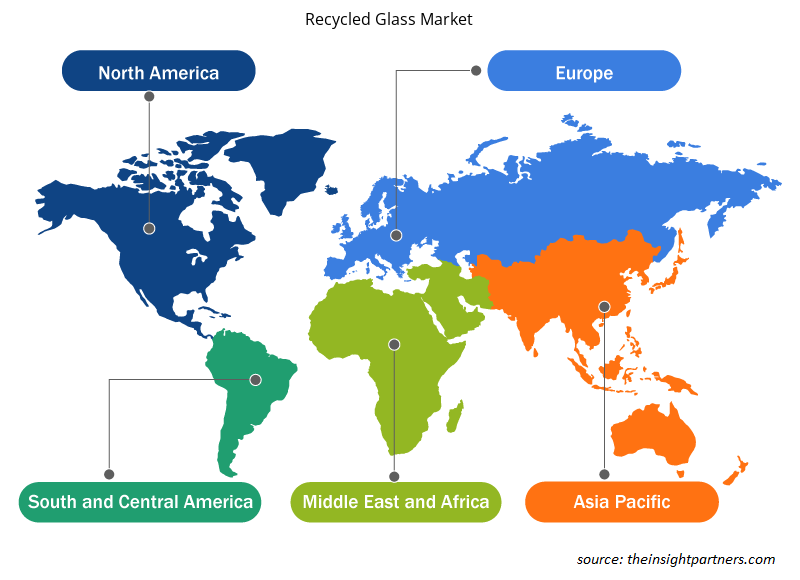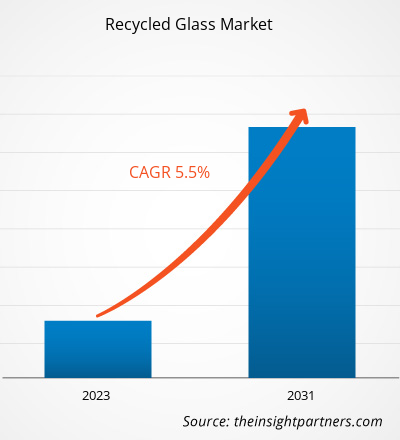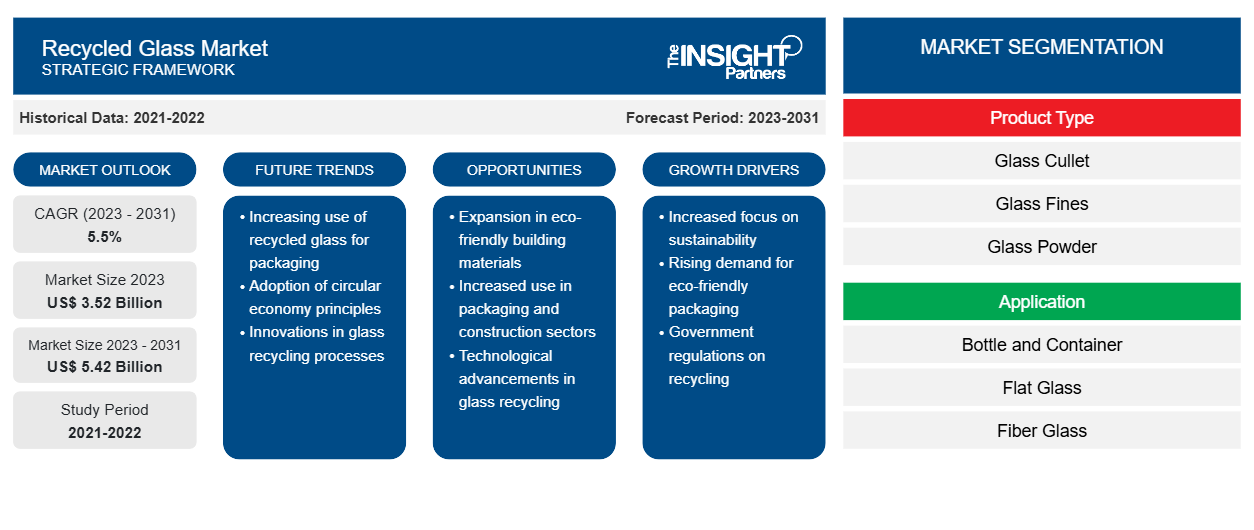Se proyecta que el tamaño del mercado de vidrio reciclado alcance los 5.420 millones de dólares estadounidenses en 2031, frente a los 3.520 millones de dólares estadounidenses en 2023. Se espera que el mercado registre una CAGR del 5,5 % entre 2023 y 2031. Es probable que el creciente enfoque en el desarrollo sostenible siga siendo una tendencia clave en el mercado de vidrio reciclado.CAGR of 5.5% in 2023–2031. The growing focus on sustainable development is likely to remain a key Recycled Glass Market trend.
Análisis del mercado del vidrio reciclado
El vidrio reciclado se utiliza ampliamente en la industria de alimentos y bebidas para el envasado de bebidas y productos alimenticios, lo que está impulsando la demanda de la industria de botellas y contenedores. El avance tecnológico en la fabricación de botellas y contenedores de vidrio reciclado tiene como objetivo mejorar la personalización y la sostenibilidad. La creciente demanda de fuentes reutilizables como alternativa a los plásticos, que son respetuosas con el medio ambiente, está animando a los fabricantes a utilizar botellas y contenedores de vidrio reciclado para envasar sus productos alimenticios y jugos.
Panorama del mercado del vidrio reciclado
El vidrio obtenido después de procesar el vidrio de desecho para convertirlo en productos utilizables se denomina vidrio reciclado. Es 100% reciclable y se puede reciclar sin ninguna pérdida de calidad o pureza. Se fabrica a partir de materiales domésticos fácilmente disponibles, como arena, piedra caliza, carbonato de sodio y vidrio reciclado listo para el horno. Además, el aislamiento de paredes , las encimeras, los contenedores y los azulejos de cocina están hechos de componentes de vidrio reciclado. Es probable que este uso creciente impulse la demanda en el mercado mundial del vidrio reciclado. Estos materiales ayudan a los fabricantes de productos de vidrio a ahorrar dinero al reducir el consumo de materia prima, disminuir las emisiones peligrosas, conservar la energía y extender la vida útil de la maquinaria de las plantas de vidrio, como los hornos. Estas características los convierten en un producto valioso en la fabricación de nuevos artículos de vidrio, lo que impulsa el mercado mundial del vidrio reciclado.cullet, which is a term for furnace-ready recycled glass. Further, countertops, containers, and kitchen tiles are all made from recycled glass components. Such increasing usage is likely to bolster the demand in the global recycled glass market. These materials help glass product makers save money by reducing raw material consumption, lowering hazardous emissions, conserving energy, and extending the life of glass plant machinery such as furnaces. These characteristics make them a valuable commodity in the manufacture of new glass items, thereby boosting the global recycled glass market.
Personalice este informe según sus necesidades
Obtendrá personalización en cualquier informe, sin cargo, incluidas partes de este informe o análisis a nivel de país, paquete de datos de Excel, así como también grandes ofertas y descuentos para empresas emergentes y universidades.
-
Obtenga las principales tendencias clave del mercado de este informe.Esta muestra GRATUITA incluirá análisis de datos, desde tendencias del mercado hasta estimaciones y pronósticos.
Factores impulsores y oportunidades del mercado del vidrio reciclado
Aumento de la adopción de aislamientos de fibra de vidrio en las industrias de uso final
El reciclaje de vidrio contribuye a un sistema de circuito cerrado, reduciendo los residuos, la contaminación y las emisiones de carbono. Como el aislamiento de fibra de vidrio es uno de los materiales más rentables, se utiliza con frecuencia en los techos de hogares y empresas. Las propiedades de aislamiento acústico de la lana de vidrio son excepcionales y la transferencia de calor también es limitada. La lana de vidrio para aislamiento acústico viene en varias formas y tamaños y es adecuada para su uso en aeronaves. La fibra de vidrio tiene una mayor relación resistencia-peso y es más duradera. También es resistente al moho y los hongos, además de poder sobrevivir a los cambios naturales. El aislamiento de lana de fibra de vidrio se utiliza en los hogares para mantenerlos frescos en verano y cálidos en invierno. Todos estos factores impulsan el mercado del aislamiento de fibra de vidrio, creando así la demanda de vidrio reciclado.mould and mildew resistant, as well as able to survive natural changes. Fiberglass wool insulation is used in homes to keep them cool in the summer and warm in the winter. All these factors drive the fiberglass insulation market, thus creating the demand for recycled glass.
Iniciativas gubernamentales en aumento para la utilización de vidrio reciclado
Los fabricantes de vidrio reciclado están trabajando en formas de aumentar la productividad y mejorar la calidad general de sus productos. Además, el aumento del número de instalaciones de producción y procesamiento dará lugar a un crecimiento significativo como resultado de numerosos programas gubernamentales y regulaciones sobre gestión de residuos, mayores tasas de reciclaje y una mayor conciencia pública sobre el desarrollo sostenible. En varios países de todo el mundo se está desarrollando un programa de depósito de residuos de vidrio. Por ejemplo, en Inglaterra, el plan de depósito y devolución del gobierno regional cubre todos los envases de bebidas hechos de plástico, metal o vidrio. El programa fue creado para reducir la cantidad de basura que daña el agua y la tierra recompensando a los consumidores que devolvieran sus latas y botellas con una pequeña recompensa monetaria. Hay planes similares en marcha en 38 países de todo el mundo, que ayudarán a fortalecer el sector del vidrio reciclado.programme was created to reduce the quantity of litter damaging the water and land by rewarding consumers who returned their cans and bottles with a small monetary reward. Similar plans are in place in 38 countries throughout the world, which will help to strengthen the recycled glass sector.
Informe de mercado de vidrio reciclado Análisis de segmentación
Los segmentos clave que contribuyeron a la derivación del análisis del mercado de vidrio reciclado son el aceite base, el tipo de producto y la industria de uso final.
- Según el tipo de producto, el mercado de vidrio reciclado se divide en vidrio molido, vidrio fino, vidrio en polvo, poliestireno y rellenos, entre otros. El segmento de vidrio molido tuvo una mayor participación de mercado en 2023.
- Por aplicación, el mercado se segmenta en botellas y envases, fibra de vidrio, vidrio plano, fibras plásticas, rellenos y otros. El segmento de botellas y envases tuvo la mayor participación del mercado en 2023.
Análisis de la cuota de mercado del vidrio reciclado por geografía
El alcance geográfico del informe del mercado de vidrio reciclado se divide principalmente en cinco regiones: América del Norte, Asia Pacífico, Europa, Medio Oriente y África, y América del Sur / América del Sur y Central.
Europa ha dominado el mercado del vidrio reciclado. Muchos países europeos están aumentando sus tasas de eliminación de residuos, reduciendo el volumen de eliminación de residuos de vidrio y fomentando el vidrio reciclado. Varios países de Europa han comenzado a poner en marcha un programa de depósito de residuos de vidrio para gestionar los residuos. En Europa, todos los envases de bebidas, ya sean de plástico, vidrio o metal, están cubiertos por el plan de depósito y devolución del gobierno, que se anunció para reducir la contaminación de la tierra y el mar al devolver una pequeña cantidad de dinero a los consumidores que devuelvan sus botellas y latas. Por lo tanto, este plan ha impulsado la demanda de reciclaje en el mercado del vidrio. Se prevé que Asia Pacífico crezca con la CAGR más alta en los próximos años.
Perspectivas regionales del mercado del vidrio reciclado
Los analistas de Insight Partners explicaron en detalle las tendencias y los factores regionales que influyen en el mercado del vidrio reciclado durante el período de pronóstico. Esta sección también analiza los segmentos y la geografía del mercado del vidrio reciclado en América del Norte, Europa, Asia Pacífico, Oriente Medio y África, y América del Sur y Central.

- Obtenga los datos regionales específicos para el mercado de vidrio reciclado
Alcance del informe de mercado de vidrio reciclado
| Atributo del informe | Detalles |
|---|---|
| Tamaño del mercado en 2023 | US$ 3,52 mil millones |
| Tamaño del mercado en 2031 | 5.420 millones de dólares estadounidenses |
| CAGR global (2023 - 2031) | 5,5% |
| Datos históricos | 2021-2022 |
| Período de pronóstico | 2023-2031 |
| Segmentos cubiertos |
Por tipo de producto
|
| Regiones y países cubiertos |
América del norte
|
| Líderes del mercado y perfiles de empresas clave |
|
Densidad de actores del mercado: comprensión de su impacto en la dinámica empresarial
El mercado del vidrio reciclado está creciendo rápidamente, impulsado por la creciente demanda de los usuarios finales debido a factores como la evolución de las preferencias de los consumidores, los avances tecnológicos y una mayor conciencia de los beneficios del producto. A medida que aumenta la demanda, las empresas amplían sus ofertas, innovan para satisfacer las necesidades de los consumidores y aprovechan las tendencias emergentes, lo que impulsa aún más el crecimiento del mercado.
La densidad de actores del mercado se refiere a la distribución de las empresas o firmas que operan dentro de un mercado o industria en particular. Indica cuántos competidores (actores del mercado) están presentes en un espacio de mercado determinado en relación con su tamaño o valor total de mercado.
Las principales empresas que operan en el mercado de vidrio reciclado son:
- Agregados Coloreados Inc.
- Compañía de vidrio Gallo
- Materiales estratégicos, Inc.
- Envase de vidrio
- Vidrio OI
- Compañía de vidrio Dlubak
Descargo de responsabilidad : Las empresas enumeradas anteriormente no están clasificadas en ningún orden particular.

- Obtenga una descripción general de los principales actores clave del mercado de vidrio reciclado
Noticias y novedades del mercado del vidrio reciclado
El mercado del vidrio reciclado se evalúa mediante la recopilación de datos cualitativos y cuantitativos a partir de una investigación primaria y secundaria, que incluye publicaciones corporativas importantes, datos de asociaciones y bases de datos. A continuación, se incluye una lista de los avances del mercado:
- La empresa embotelladora Coca-Coca UNITED se ha comprometido a crear un mundo sin residuos y tiene como objetivo utilizar el 50 % de material reciclado en sus botellas para 2030. La empresa embotelladora se ha asociado con OI Glass para capturar más vidrio reciclado para fabricar nuevas botellas de vidrio. (Fuente: OI Glass, Noticias de la empresa, 2022)
- Strategic Materials, Inc., el reciclador de vidrio más grande de Norteamérica, anunció hoy el lanzamiento de un medio de filtración ecológico, TruFiltration, fabricado con vidrio 100 % reciclado, que brinda servicio a los mercados de filtración residencial y comercial. (Fuente: Strategic Materials, Inc., Noticias de la empresa, 2021)
Informe sobre el mercado del vidrio reciclado: cobertura y resultados
El informe “Tamaño y pronóstico del mercado de vidrio reciclado (2021-2031)” proporciona un análisis detallado del mercado que cubre las siguientes áreas:
- Tamaño del mercado y pronóstico a nivel global, regional y nacional para todos los segmentos clave del mercado cubiertos bajo el alcance
- Dinámica del mercado, como impulsores, restricciones y oportunidades clave
- Principales tendencias futuras
- Análisis detallado de las cinco fuerzas de Porter y FODA
- Análisis del mercado global y regional que cubre las tendencias clave del mercado, los principales actores, las regulaciones y los desarrollos recientes del mercado.
- Análisis del panorama de la industria y de la competencia que abarca la concentración del mercado, el análisis de mapas de calor, los actores destacados y los desarrollos recientes
- Perfiles detallados de empresas
- Análisis histórico (2 años), año base, pronóstico (7 años) con CAGR
- Análisis PEST y FODA
- Tamaño del mercado, valor/volumen: global, regional y nacional
- Industria y panorama competitivo
- Conjunto de datos de Excel
Informes recientes
Informes relacionados
Testimonios
Razón para comprar
- Toma de decisiones informada
- Comprensión de la dinámica del mercado
- Análisis competitivo
- Información sobre clientes
- Pronósticos del mercado
- Mitigación de riesgos
- Planificación estratégica
- Justificación de la inversión
- Identificación de mercados emergentes
- Mejora de las estrategias de marketing
- Impulso de la eficiencia operativa
- Alineación con las tendencias regulatorias























 Obtenga una muestra gratuita para - Mercado de vidrio reciclado
Obtenga una muestra gratuita para - Mercado de vidrio reciclado